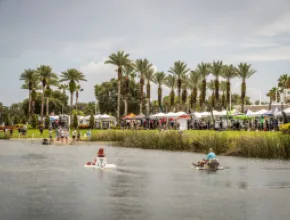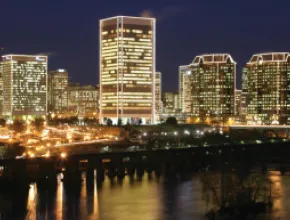My Dad is a college football fan. In an effort to demonstrate his dedication and to perhaps prove he deserves 50-yard-line tickets to each major bowl game, every year for the rest of his life, the man is on a mission to amass an unparalleled collection of baseball hats sporting university logos. The deal is, of course, the hat must be purchased directly from the school’s campus. He’s already tackled many a hallowed ground, from Notre Dame,
Boston College and Penn State to the universities of Michigan, Kansas, Florida, Virginia, Tennessee, and Southern California.
Most recently, on a cross-country trip heading home from his native Massachusetts to Eugene, Ore. (Did I mention he’s got a University of Oregon cap? Go Ducks!), Dad made a beeline to Lincoln to kick around the University of Nebraska.
University of Nebraska football, you see, is “big, BIG-time football,” according to Dad. During his visit, he basked in Cornhusker glory and recalled great plays executed on Tom Osborne Field.
Of course, with every college football team and campus comes a college town that Dad gets equally jazzed about, and his report on Lincoln was glowing.
He couldn’t agree more with Derek Feyerherm, director of sales at the Lincoln CVB.
“Here, you get that Midwestern vibe and hospitality with the amenities of a big city,” Feyerherm says. “But it’s definitely a small-town feel, a place where people in cars let pedestrians cross the street instead of running lights.”
Situated at the country’s core, at once away from it all and in the center of everything, Lincoln is conveniently poised to welcome drive-in meetings in particular.
“We’re almost smack-dab in the middle of the country,” Feyerherm says, explaining Lincoln is within a five- to six-hour drive from many other locales. “Our biggest markets are regional and state associations.”
He adds that with a crime rate that’s “next to nothing,” it’s safe to walk around downtown Lincoln, even at night. This feeling of security makes for comfortable and content delegates, who after the meeting will enjoy exploring Lincoln’s attractions and surrounding parks and golf courses, and celebrating what brought my Dad there—Husker heritage.
Capital Meeting Space
Nebraska’s capital city, known as the “Prairie Capital” because it also celebrates the pioneer history of the Midwest and the Great Plains, offers some terrific facilities for groups.
For starters, the capitol building is “one of four skyscraper capitols in the U.S. where groups can have a reception surrounded by beautiful mosaics and marble,” Feyerherm says.
One of the three largest meetings-equipped hotels in town, the 231-room Holiday Inn Lincoln Downtown, is on track to complete a full interior renovation and a brand-new facade that complements the 1880s red brick of the Historic Haymarket district where it resides, Feyerherm says. The project is scheduled for completion by the end of 2009.
The city’s largest hotel, with 297 rooms and 46,000 square feet of meeting space, is The Cornhusker, A Marriott Hotel, located in downtown Lincoln about five blocks from the University of Nebraska.
Another star player is the Embassy Suites Lincoln, situated a block away from campus and featuring 252 guest rooms and roughly 22,000 square feet of meeting space.
The Lancaster Event Center at the far eastern edge of Lincoln is another standout facility, hosting agriculture and horse shows, expos and the county fair, among other events. According to Feyerherm, it’s currently undergoing an expansion to add another pavilion for a total of approximately 400,000 square feet of space. The project is scheduled for completion by the end of 2008.
Meanwhile, discussions are under way for a major project in the western portion of the Historic Haymarket district. Feyerherm says a public arena is expected to go on the ballot in 2009, and if it passes, a hotel and a convention center should follow.
Husker Haven
Since its 1962 season, University of Nebraska football games have annually sold out. For those who aren’t current students, alumni, lucky season ticket holders, or otherwise appropriately connected, getting a seat to watch the Huskers in action could be as challenging as throwing a touchdown pass.
“The stadium has added additional seating and sky boxes, but there is still a waiting list,” Feyerherm says. “We actually encourage planners to look at booking during times outside of Husker games because during game time it’s more expensive. We suggest looking during the week or on off-weekends during football season, when the team is playing away.”
Even if not in the thick of a game day complete with rowdy University of Nebraska fans, cheerleaders and the marching band, there are a few ways for planners to incorporate Husker heritage into meeting agendas.
Groups are encouraged to enjoy the University of Nebraska athletic experience during a convention in Lincoln, according to Jeff Maul, vice president and executive director of the Lincoln CVB.
While a Husker football game day is an experience in itself, tickets are hard to come by.
“But convention delegates in Lincoln can experience much of that same tradition as part of an opening night reception or a day-long experience of education and fun,” Maul says.
Many groups consider hosting a portion of their event at the university, complete with entertainment, speakers and education.
Delegates can also simply get their walking shoes on and tour the university’s two campuses, which often host academic conferences.
“Both campuses are in Lincoln and accessible, and they’re both very distinct,” Feyerherm says, explaining the urban atmosphere of its City Campus and the agricultural feel of its East Campus.
Aside from Husker football, Lincoln has become something of a sports meetings magnet, according to Feyerherm.
“We really are a sports town, even during the summer—it’s a thriving business right now,” he says, citing two off-campus sports facilities that host events: the Nebraska Tennis Center and the Abbott Sports Complex.
In 2010 Lincoln is hosting the National Games for the Special Olympics. About 30,000 people will attend the event, which occurs in various locations every four years just like the traditional Olympic Games.
Off-Sites, Great Plains Style
There is no shortage of venues in Lincoln to hold an off-site meeting or an off-session group outing or reception.
Situated on the University of Nebraska City Campus is the Sheldon Museum of Art. The museum, which houses a tremendous collection of 20th century contemporary art—including works by Edward Hopper, Mary Cassatt, Georgia O’Keeffe, Jackson Pollock, and Andy Warhol—often hosts receptions in its Great Hall, the two-story public entranceway; seminars in its Ethel S. Abbott Auditorium; and outdoor events in its Sculpture Garden.
Another option for outdoor receptions, Feyerherm adds, is the Lester F. Larsen Tractor Test and Power Museum on the University of Nebraska’s East Campus, where groups can learn about the evolution of the tractor and watch tractors being tested.
“We promote this museum since we’re an agriculture state,” Feyerherm says. “Especially when dealing with national groups and even some regional groups who don’t have the experience of farm life—they find it very interesting.”
When the International Quilt Study Center and Museum, a “green” building that houses the world’s largest collection of quilts, plus meeting space, opened its doors in March, there were 1,500 people representing five countries in line, according to Feyerherm.
Another out-of-the-ordinary option for off-sites is Spring Creek Prairie Audubon Center, situated right outside Lincoln in Denton, Neb., on prairie ground that has never been touched by plow or truck, according Feyerherm.
“You could see the original wagon ruts from the Oregon trail,” he says. “It’s pristine, what you would have encountered 200 years ago."
For More Info:
Lincoln CVB 402.434.5335 www.lincoln.org






